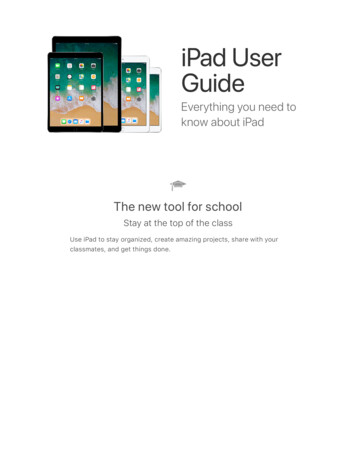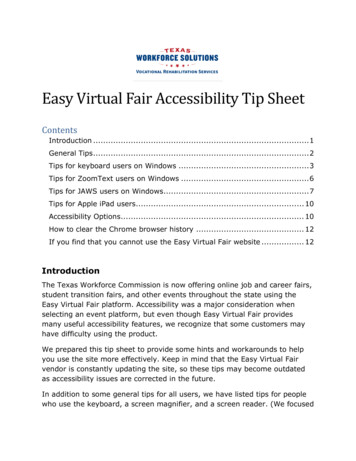
Transcription
Tips forConductingTable Exercises
Planning for a Tabletop ExercisePlanning is key to ensuring a tabletop exercise will be productive and useful for participatingstakeholders. The following is a list of the major elements involved in planning for a tabletopexercise: Identify the stakeholders who will participate in the exercise. Develop a script for the exercise, including surprise elements. Provide a timeline for the exercise to play-out (the exercise will probably take place in anaccelerated timeframe compared to a real-life event). Identify reviewers who will watch the exercise and take notes. Provide time to review the exercise. Modify the plan based on what was learned during the exercise.
ParticipantsThe purpose of a tabletop exercise is to encourage discussion among the stakeholders and todevelop recognition of coordination and planning requirements. This can only be accomplished ifgroup discussion takes place freely and without embarrassment to any individual or service. Inorder to ensure this type of environment exists, care must be taken when identifying a facilitatorfor the tabletop exercise. The facilitator of the exercise should be someone who isknowledgeable with the planning and implementation of the transportation plans for plannedspecial events but who is not an exercise "player." Ideally, this would either be the trafficengineer or an instructor who has the responsibility and knowledge of planned special eventsand resources available in your community.Planned special events tabletop exercise participants should (at least) include representatives offire and rescue, police/law enforcement, transportation and/or public works, venuerepresentatives, transit, emergency medical services, towing and recovery, elected officials,public information, and emergency management, and, if appropriate, a representative from thetransportation operations center. Additional details concerning the roles and responsibilities ofstakeholders typically involved with the traffic management for unplanned incidents is discussedin greater detail in the Roles and Responsibilities section.In addition, since participants can not be expected to remember all that takes place during theexercise, it is critical that observers be used to: (1) watch what happens, (2) take notes on whatis seen and heard, and (3) recount observations during the review process.
ScenariosThe goal of preparing a tabletop exercise for a specific emergency is not to be mistake free, butto identify potential problems areas. For tabletop exercises to be effective, they should test asmany parts of the potential emergency as possible using scenarios. A number of scenarios thatcause disruptions to the emergency planning or response should be developed, keeping in mindthat the scenarios should be as realistic as possible. Often times during a tabletop a simplescenario is presented to initiate discussion, and as the exercise progresses the scenario isescalated. During scenario discussions, operational problems and solutions can be identified.These scenarios typically do not require modeled network information, as their primary purposeis to test the stakeholders as to how they would react and to fine tune the responsibilities of eachstakeholder and the communications protocol between the stakeholders.
After Action ReviewAfter action reviews are conducted after a tabletop, or any exercise, has ended. The purpose ofthe review is to: Evaluate changes and corrections to the original emergency response plan. Evaluate what if any additional interagency or inter-department coordination is needed. Serve as a guide for future exercises. Verify the exercise goals were achieved. Evaluate training and staff deficiencies.Participant input is also crucial in the review process. They can note difficulties experiencedduring the exercise that might not be obvious to observers. Reviewers should debriefparticipants as soon as possible after the exercise so participants do not forget what theyexperienced. These participant observations should also be included in a more extensive reviewof the exercise. Individuals who do not represent day-of event response team personnel or eventstakeholders can be very useful in moderating the review process since they do not bring real orperceived bias into the process. Finally, all of the observations and insights are useless unlessthere exists some opportunity to incorporate recommended changes into the transportationmanagement plan.
Tips to Ensure an Effective Tabletop ExerciseThe following guidelines will ensure your tabletop exercise is more effective: The exercise should be held in a room with a conference table, or with the seatingarranged in a manner in which the participants are able to see all other participants. Have refreshments available for the participants helps promote a relaxed atmosphere. Provide a large detailed map/drawing of the exercise area so that all participants canvisualize the area involved. A recorder (not an exercise "player") should write down exercise responses and note themajor issues/problems. Plan on at least one hour, preferably three for the exercise. If the exercise fails to becomeproductive within the first hour, it's best to discontinue and discuss the possible reasonswhy this has occurred. After the exercise, all participants should be asked to complete an evaluation of theexercise, and make suggestions and comments with regard to emergency operations planrevisions. Schedule future meetings to revise the plan shortly after this tabletop exercise, whilethoughts are still fresh in everyone's mind, may be appropriate. Additional tabletop exercises may be needed to evaluate the revisions/accomplish localgoals of this exercise.
Planning is key to ensuring a tabletop exercise will be productive and useful for participating stakeholders. The following is a list of the major elements involved in planning for a tabletop











